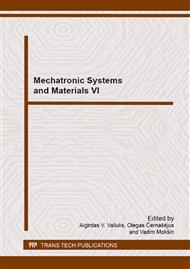[1]
Tungaloy Inc., America, Products for Machining High Temp Alloy Materials, Product Selection Guide, No. 204, Information on http: /www. tungaloyamerica. com/pdf/High%20Temp%20web. pdf.
Google Scholar
[2]
E.O. Ezugwu, Improvements in the machining of aero-engine alloys using self-propelled rotary tooling technique, Journal of Materials Processing Technology 185 (2007) 60–71.
DOI: 10.1016/j.jmatprotec.2006.03.112
Google Scholar
[3]
Information on http: /www. haynesintl. com/pdf/h3057. pdf.
Google Scholar
[4]
L.N. Lacelle, J.A. Sanchez, A. Lamikiz, A. Celaya, Plasma assisted milling of heat – resistant superalloys, Journal of Manufacturing Science and Engineering 126 (2004).
DOI: 10.1115/1.1644548
Google Scholar
[5]
Ş. Aykut, E. Bağcı, A. Kentli, O. Yazıcıoğlu, Experimental observation of tool wear, cutting forces and chip morphology in face milling of cobalt based super-alloy with physical vapour deposition coated and uncoated tool, Materials and Design 28 (2007).
DOI: 10.1016/j.matdes.2006.04.014
Google Scholar
[6]
M. Benghersallah, L. Boulanouar, G. Le Coz, A. Devıllez, D. Dudzınskı, Machinability of stellite 6 hardfacing, Epc Web of Conferences 6 (2010).
DOI: 10.1051/epjconf/20100602001
Google Scholar
[7]
M.A. Xavior, M. Adithan, Determining the influence of cutting fluids on tool wear and surface roughness during turning of AISI 304 austenitic stainless steel, Journal of Materials Processing Technology 209 (2209) 900–909.
DOI: 10.1016/j.jmatprotec.2008.02.068
Google Scholar
[8]
D.C. Montgomery, Design and Analysis of Experiments, 4th ed., Wiley, New York, (1997).
Google Scholar
[9]
A.N. Haq, P. Marimuthu, R. Jeyapaul, Multi response optimization of machining parameters of drilling Al/Sic metal matrix composite using grey relational analysis in the Taguchi method, Int. J. Adv. Manuf. Technol. 37 (2008) 250–255.
DOI: 10.1007/s00170-007-0981-4
Google Scholar
[10]
E. Bağcı, Ş. Aykut, A study of Taguchi optimization method for identifying optimum surface roughness in CNC face milling of cobalt-based alloy (stellite 6), Int. J. Manuf. Technol. 29 (2006) 940–947.
DOI: 10.1007/s00170-005-2616-y
Google Scholar
[11]
T.H. Hou, C.H. Su, W.L. Liu, Parameters optimization of a nano-particle wet milling process using the Taguchi method, response surface method and genetic algorithm, Powder Technology 173 (2007) 153–162.
DOI: 10.1016/j.powtec.2006.11.019
Google Scholar
[12]
J.A. Ghani, I.A. Choudhury, H. H Hassan, Application of Taguchi method in the optimization of end milling parameters, Journal of Materials Processing Technology 145 (2004) 84–92.
DOI: 10.1016/s0924-0136(03)00865-3
Google Scholar
[13]
M. Nalbant, H. Gökkaya, G. Sur, Application of Taguchi method in the optimization of cutting parameters for surface roughness in turning, Materials and Design 28 (2007) 1379–1385.
DOI: 10.1016/j.matdes.2006.01.008
Google Scholar
[14]
A. Hasçalık, U. Çaydaş, Optimization of turning parameters for surface roughness and tool life based on the Taguchi method, Int. J. Adv. Manuf. Technol. 38 (2008) 896–903.
DOI: 10.1007/s00170-007-1147-0
Google Scholar
[15]
W.H. Yang, Y.S. Tarng, Design optimization of cutting parameters for turning operations based on the Taguchi method, Journal of Materials Processing Technology 84 (1998) 122–129.
DOI: 10.1016/s0924-0136(98)00079-x
Google Scholar
[16]
R. Suresh, S. Basavarajappa, V.N. Gaitonde, G.L. Samuel, Machinability investigations on hardened AISI 4340 steel using coated carbide insert, Int. Journal of Refractory Metals and Hard Materials 33 (2012) 75–86.
DOI: 10.1016/j.ijrmhm.2012.02.019
Google Scholar
[17]
T. Kivak, G. Samtas, A. Cicek, Taguchi method based optimisation of drilling parameters in drilling of AISI 316 steel with PVD monolayer and multilayer coated HSS drills, Measurement 45 (2012) 1547–1557.
DOI: 10.1016/j.measurement.2012.02.022
Google Scholar


